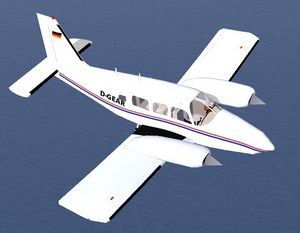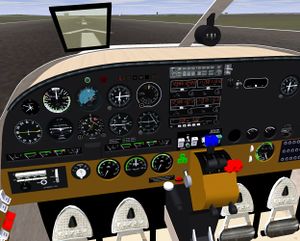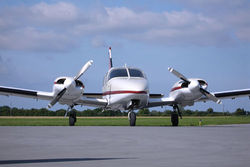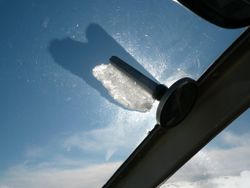Piper PA34-200T Seneca II
 | |
|---|---|
 | |
 The 3D cockpit | |
| Type | Civil aircraft, Civil utility aircraft |
| Propulsion | Twin-engine aircraft |
| Manufacturer | Piper |
| Author(s) | Torsten Dreyer |
| FDM | JSBSim |
| --aircraft= | SenecaII |
| Status | Production |
| FDM |
|
| Systems |
|
| Cockpit |
|
| Model |
|
| Supports |
|
| Development | |
| Website |
|
| Repository |
|
| Download |
|
| License | GPLv2+ |
|
| |
Introduction
This is a model of a Piper PA34-200T Seneca II. The Seneca has been made by Piper since the early 1970's and some 4500 were made since then. It has six seats in a pretty large cabin, two turbocharged counterrotating engines producing 200hp up to 12,000 ft. It cruises at 170ktas in 12,000ft at 65% power. Certification for flights into known icing conditions and the nice single engine behaviour made the Seneca a popular multi engine trainer.
The model was built using the Pilots Operating Handbook, a real Seneca (D-GEJL) and some flight performance data derived in real flights.
Features
Full functional 3d cockpit
Almost all controls, switches, gauges and indicators are implemented and functional in the cockpit. For description of the panel have a look at the Seneca II Panel Reference. The default KI227 ADF indicator can be exchanged into a KI228 RMI indicator coupled to ADF and NAV1 radio. To use the KI228, simply set the property
/instrumentation/adf/model
to
ki228
in the property browser or use the command line switch
--prop://instrumentation/adf/model=ki228
when starting up the Seneca.
Tutorials
Using the menu items Help->Start Tutorial a bunch of tutorials are reachable.
- Cold Start Puts your aircraft into hibernation mode. Everything is off.
- Hot Start Everything is ready to go, just start the engines and fly.
- Check These are the checklists from Seneca II Checklist
Structural Icing
Since the Seneca provides anti- and deice equipment, I tried to model structural icing into flightgear. A little nasal script does most of the work: First it reads the property nodes under /sim/model/icing where any number of iceable elements configure the ice sensitive elements of the aircraft. Each element have a name, a sensitivity to icing, may have a salvage control and the name of a output property where the collected amount of ice is written to. After the initial configuration, a timed loop is executed every 2 seconds. It
- calculates the spread by OAT and dewpoint
- checks visibility (see remark) to tell if the aircraft is within clouds
- if the spread is below 0.1 degc and visibility is below 1000m, assumes potential icing condition and icing severity is calculated
- update all ice sensitive elements with the current icing conditions
The icing severities are defined as
| severity | inches | per NM (still air) |
|---|---|---|
| NONE | -0.3 | 80 |
| TRACE | 0.5 | 80 |
| LIGHT | 0.5 | 40 |
| MODERATE | 0.5 | 20 |
| SEVERE | 0.5 | 10 |
The rule for calculating the severity is
| OAT_min | OAT_max | severity_min | severity_max |
|---|---|---|---|
| -99 | -30 | NONE | TRACE |
| -30 | -20 | TRACE | LIGHT |
| -20 | -12 | LIGHT | SEVERE |
| -2 | -0 | NONE | MODERATE |
| 0 | 999 | NONE | NONE |
When oat is above zero degc, Ice melts at a rate of 0.5" per 10NM at 10degc, the warmer the faster.
Pitot Icing
The pitot tube is prone to icing, too. A little agent is waiting for you to get into icing conditions without switching on the pitot heat. If he gets you, he will fail your pitot system which will result in some strange airspeed indicator behaviour.
Pilot Operating Handbook
General
Engines
| Number of Engines | 2 |
| Engine Manufacturer | Continental |
| Engine Model Number | (L)TSIO-360EB |
| Rated Horsepower | Sea Level: 200, 12,000ft.: 215 |
| Rated Speed (rpm) | 2575 |
| Bore (inches) | 4.438 |
| Stroke (inches) | 3.875 |
| Displacement (cubic inches) | 360 |
| Compression Ratio | 7.5:1 |
| Engine Type | Six Cylinder, Direct Drive, Horizontally Opposed, Air Cooled |
Propellers
| Number of Propellers | 2 |
| Propeller Manufacturer | Hartzell |
| Number of Blades | 2 |
| Propeller Diameter | Maximum: 76 inches, Minimum: 75 inches |
| Propeller Type | Constant Speed, Hydraulically Actuated, Full Feathering |
Fuel
| Fuel Capacity (U.S.gal) (total) | 128 |
| Usable Fuel (U.S.gal) (total) | 123 |
| Minumum Grade | 100 Green or 100LL Blue Aviation Grade |
Oil
| Oil Capacity (U.S.quarts) (per engine) | 8 |
Maximum Weights
| Maximum Takeoff Weight (lbs) | 4570 |
| Maximum Landing Weight (lbs) | 4362 |
| Maximum Zero Fuel Weight (lbs) - Standard | 4000 |
| Maximum Weight in Baggage Compartment (lbs) | Forward: 100, Aft: 100 |
Standard Airplane Weights
| Standard Empty Weight (lbs): Weight of a standard airplane including unusable fuel, full operating fluids and full oil. | 2823 |
| Maximum Useful Load (lbs): The difference between the Maximum Takeoff Weight and the Standard Empty Weight. (All weight in excess off 4000lbs must consist of fuel) | 1747 |
Specific Loadings
| Wing Loading (lbs per sq ft) | 22 |
| Power Loading (lbs per hp) | Sea Level: 11.4 - 12,000ft: 10.6 |
Limitations
Airspeed Limitations
| Speed | KIAS | KCAS |
|---|---|---|
| Never Exceed Speed (VNE) - Do not exceed this speed in any operation | 195 | 195 |
| Maximum Structural Cruising Speed (VNO) - Do not exceed this speed except in smooth air and then only with caution. | 163 | 165 |
| Design Maneuvering Speed (VA) - Do not make full or abrupt control movements above this speed. | ||
| At 4570 LBS G.W. | 136 | 138 |
| At 3068 LBS G.W. | 121 | 122 |
|
CAUTION Maneuvering speed decreases at lighter weight as the effects of aerodynamic forces become more pronounced. Linear interpolation may be used for imtermediate gross weights. maneuvering speed should not be exceeded while operating in rough air. | ||
| Maximum Flaps Extended Speed (VFE) - Do not exceed this speed with flaps extended. | 107 | 109 |
| Maximum Gear Extended Speed (VLE) - Do not exceed this speed with landing gear extended | 129 | 130 |
| Maximum Landing Gear Extending Speed (VLO) - Do not extend landing gear above this speed | 129 | 130 |
| Maximum Landing Gear Retracting Speed (VLO) - Do not retract landing gear above this speed | 107 | 109 |
| Air Minimum Control Speed (VMC) - Lowes airspeed at which airplane is controllable with one engine operating and no flaps | 66 | 69 |
| Best Single Engine Rate of Climb Speed | 89 | 90 |
Airspeed Indicator Markings
| Marking | KIAS |
|---|---|
| Green Arc (Normal Operating Range) | 63 to 163 |
| Yellow Arc (Caution Range - Smooth Air) | 163 to 195 |
| White Arc (Flaps Extended Range) | 61 to 107 |
| Radial Red Line (Never Exceed - Smooth Air) | 195 |
| Radial Red Line (Minimum Control Speed - Single Engine) | 66 |
| Radial Blue Line (Best Rate of Climb Speed - Single Engine) | 89 |
Power Plant Limitations
| Maximum Rotational Speed | 2575 |
| Maximum Manifold Pressure (Inches of Mercury) | 40 |
| Maximum Cylinder Head Temperature | 460 °F |
| Maximum Oil Temperature | 240 °F |
| Minimum Oil Pressure (red line) | 10 PSI |
| Maximum Oil Pressure (red line) | 100 PSI |
|
NOTES Avoid continuous operation between 2000 and 2000 RPM above 32 IN. HG. manifold pressure. Avoid continuous ground operation between 1700 and 2100 RPM in cross and tail winds over 10 knots. | |
Power Plant Instrument Markings
| Tachometer | |
|---|---|
| Green Arc (Normal Operating Range) | 500 RPM to 2575 RPM |
| Red Line (Maximum) | 2575 RPM |
| Fuel Flow and Pressure | |
| Green Arc (Normal Operating Range) | 3.5 PSI to 20 PSI |
| Red Line (Maximum at Sea Level) | 25 GPH (20PSI) |
| Red Line (Minimum) | 3.5 PSI |
| Cylinder Head Temperature | |
| Green Arc (Normal Range) | either 360 °F to 460 °F |
| or 240 °F to 460 °F | |
| Red Line (Maximum) | 460 °F |
| Oil Temperature | |
| Green Arc (Normal Operating Range) | either 75 °F to 240 °F |
| or 100 °F to 240 °F | |
| Red Line (Maximum) | 240 °F |
| Oil Pressure | |
| Green Arc (Normal Operating Range) | either 30 PSI to 80 PSI |
| or 30 PSI to 60 PSI | |
| Yellow Arc (Caution) | either 80 PSI to 100 PSI |
| or 60 PSI to 100 PSI | |
| Red Line (Minimum) | 10 PSI |
| Red Line (Maximum) | 100 PSI |
| Manifold Pressure | |
| Green Arc (Normal Operating Range) | 10 IN. to 40 IN. HG. |
| Red Line (Maximum) | 40 IN. HG. |
| Exhaust Gas Temperature | |
| Red Line | 1650 °F |
Center of Gravity Limits
| Weight Ponds |
Forward Limit Inches Aft of Datum |
Aft Limit Inches Aft of Datum |
|---|---|---|
| 3400 | 82.0 | 94.6 |
| 4570 | 90.6 | 94.6 |
NOTES
Straight line variation between the points given.
Datum is 78.4 inches forward of wing leading edge from the inboard edge of the inboard fuel tank.
Maneuver Limits
All intentional acrobatic maneuvers (including spins) are prohibited. Avoid abrupt maneuvers.
Flight Load Factor Limits
| Positive Load Factor (Maximum) | 3.8 G |
| Negative Load Factor (Maximum) | No inverted maneuvers approved |
Types of Operations
The airplane is approved for the following operations when equipped in accordance with FAR 91 or FAR 135
- Day VFR
- Night VFR
- Day IFR
- Night IFR
- Icing conditions when equipped.
Fuel Limitations
The usable fuel in this aircraft is 61.5 gallons in each wing or a total of 123 gallons.
Gyro Pressure Limits
The operating limits for the pressure system are 4.5 to 5.2 inches of mercury for all operations as indicated by the gyro pressure gauge.
Flight Into Known Icing Conditions
For flight in icing conditions the following equipment must be installed inaccordance with Piper drawings or in an FAA approved manner:
- Pneumatic wing end empennage boots
- Electrothermal propeller boots
- Electric windshield panel
- Heated pitot head
- Wing ice light
- Heated lift detectors
- Propeller spinners must be installed
Operating Altitude Limitations
Flight above 25,000 feet is not approved. Flight up to and including 25,000 feet is approved if equipped with oxygen in accordance with FAR 23.1441 and avionics in accordance with FAR 91 or FAR 135.
Development status/Issues/Todo
FDM (JSBSim):
- poor single engine performance
- flap operation should not emit a flap motor sound
- moving aircraft with parking brake set and full power
Avionics:
- No transponder.
REMARK: There is a GTX330 transponder as an empty 3d model without functionality.
- No GPS.
REMARK: There is a GPS155XL GPS as an empty 3d model without functionality.
General:
- engine sound in cockpit does not differ from outside engine sound
- animations of structural icing on wings, stabilizer, fin, etc.missing
Related content
- Seneca II Checklist
- Howto:Seneca II
- Seneca II Panel Reference
- HSI, Horizontal Situation Indicator
- KX165 COM/NAV Radio
| |||||

